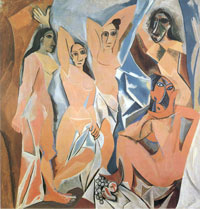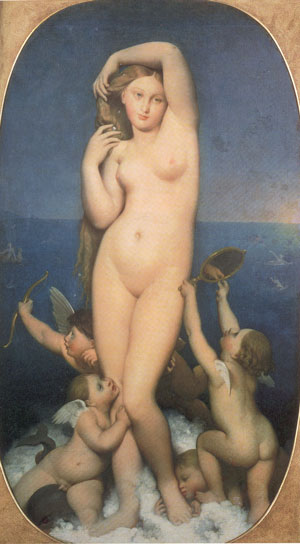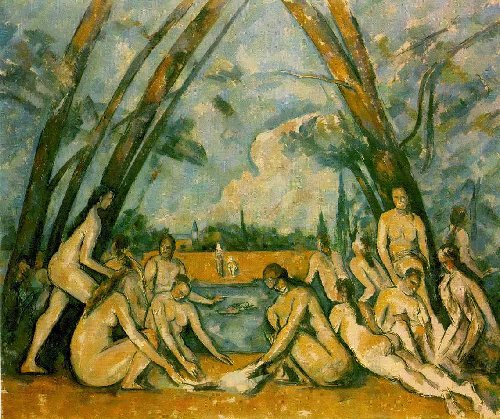

Les Demoiselles d'Avignon
Venus Anadyomene


Ancient Egyptian poses

Paul Cézanne. The Bathers (1904). Oil on canvas.

Last stages of a syphilitic patient
| Picasso's Les Demoiselles d'Avignon: Breaking with Tradition | |
|
Perhaps the most radical
painting of the twentieth-century, Les Demoiselles d'Avignon, hangs
unobtrusively at the Museum of Modern Art in New York City. This large
canvas, measuring 96" x 92", was to revolutionize modern painting by
charting a new way of depicting reality. In 1907 its painter, Pablo Picasso,
broke all of the rules that the "artistically correct" learned at the art
academies: he disposed of three-dimensional perspective, abandoned
harmonious proportion, used distortion, and borrowed from the art of
primitive cultures. In fact, the painting was such a revolutionary statement
that when the painting was first viewed by some French critics, the painter
Derain even suggested to Picasso that he would one day commit suicide for
the shame that he had brought on the art establishment. |
|
|
Originally Les Demoiselles was going to be an allegory of venereal
disease entitled "The Wages of Sin." In the study for the painting, Picasso
sketched a sailor carousing in a brothel amongst prostitutes and a young
medical student holding a skull, a symbol for mortality. But the subsequent
painting is quite different from the original sketch: only the women appear.
And these women are not the traditional nudes that viewers had become so
accustomed to in the 1880's when Degas and Toulouse-Lautrec had begun to
capture them in the moment of the "parade," whereby prostitutes announced
their wares and services to their clients. Nor are these women feminine and
beautiful as Ingres’ Venus Anadyomene. Then who are these women in
this brothel in
Barcelona's
Avignon Street and why do they appear the way they do? Perhaps the answers
to these questions lie in Picasso's fear of women in general. Their flesh is
not depicted as being soft and inviting but sharp and knifelike. In fact,
their flesh suggests castration and fear of women. As Robert Hughes implies,
"No painter put his anxiety about impotence and castration more plainly than
Picasso did in Les Demoiselles, or projected it through a more
violent dislocation of form. Even the melon, that sweet and pulpy fruit,
looks like a weapon". But are there any other reasons why Picasso gives
these women these shocking forms? |
 
Les Demoiselles d'Avignon
Venus Anadyomene |
|
As an artist living in
Paris at the beginning of the new 20th century, Picasso wanted to
find a new artistic language that could express the vitality of the new
millennium. Although the world was rapidly changing, artists had not kept
pace and were still wallowing in the aesthetic ideas of the
nineteenth-century. The real world had radically changed, for it had become
mechanized by technology. Moreover, philosophers such as Alfred Whitehead
and F. H. Bradley and the physicist Alfred Einstein were altering the way
modern man perceived reality: the world of old Newtonian values of absolute
space and time was rapidly crumbling. Instead, modern man was being forced
to live in a world where there are no simple locations and where all
relations are plural. Picasso posed the problem to himself of how to capture
this new acceleration of life and consequent plurality of points of view on
a canvas. He proposed to solve this aesthetic problem by creating a new way
of representing pictorial space. |
|
|
Since the late 18th
century, artists had been re-evaluating the Renaissance's concept of
pictorial space, created through the means of linear and atmospheric
perspective, whereby a fixed spectator observed a cube of space in which the
sense of depth was created by a geometric diminution of objects in scale and
in clarity as, apparently, they receded into the distance.. For Picasso,
this rendering of space was no longer valid because the "fixed spectator" no
longer existed. Now the modern spectator had been transformed into someone
who was in constant movement, forced to look at objects from several points
of view. Picasso became obsessed with what he regarded as the anachronistic
artistic rules governing the representation of three-dimensional form on a
flat surface and with reconciling them with the new modern acceleration.
Les Demoiselles d'Avignon represents a working out of this
reconciliation. His solution was to paint five nude contorted women. |
|
| Now let's examine why he would portray them in such a manner. If we examine the seated woman to our right, you'll notice that her face and arms are facing us but her torso, buttocks and extremities are turned away from us. In other words, Picasso lets us simultaneously glimpse at different aspects of this woman that a fixed viewer could not ordinarily do so. In other words, Picasso is trying to show us a composite of this woman from as many different points of view as possible so that we may experience her in her totality. Picasso does the very same thing to the woman standing to our left. If we examine her closely, we will notice that she is ambiguously portrayed. First of all, her face is depicted both laterally and frontally. She is posed like an ancient Egyptian form who looks to the side but whose eye looks directly to the front. Furthermore, if we inspect her body, we will discover something very odd. Her right side is depicted dorsally, whereas her left side is portrayed frontally. It's as if Picasso has twisted her body so that we may get a glimpse of as many aspects of her as possible. In other words, Picasso wants to show us this woman in her entirety. | 
 Ancient Egyptian poses |
| In rendering the new
reality, Picasso also abandons harmonious bodily proportions. This, of
course, was done on purpose since Picasso had been trained at art school how
to render the human figure through mathematical proportions. The woman
located at the very center of the canvas is quite disproportionate,
elongated as though she were a figure out of an El Greco painting. If we
focus on her extremities, they seem to go on forever, as if her short-waisted
torso was out of context with the rest of her body. And so it goes for the
rest of the figures in the picture. Was there any precedent for doing such a
thing? Picasso's Les Demoiselles is a homage to Paul Cézanne's The
Bathers. Not only do both works echo Cezanne's dictum of "the cone, the
cylinder, and the sphere," but both paintings distort the human body.
However, whereas Cezanne distorts the women in The Bathers in order
to bring the viewer into the pictorial plane and to balance the figures and
structures within the painting, Picasso does so for a different purpose.
Picasso distorts each of these women to show who is in power—that he can
take control and mangle them—and that, in the final analysis, they still
threaten him as human beings.
|
|
|
But this distortion and
use of pure geometrical shapes are not the only elements that Picasso
borrows from Cezanne's work. Picasso limits his palette just as Cezanne does
because both are concerned more with the rendering of form than with the use
of color. To have used more colors than the blues, pinks, ochres, rusts, and
grays that he employs would have been distracting. Furthermore, these colors
are totally flat, as though to suggest that these women are linearly
rendered, "constructed" rather than modeled. |
|
| Les
Demoiselles
is also disturbing in the ghastly and violent way that the women's faces are
portrayed. Georges Braque went so far as to say that "Picasso was drinking
turpentine and spitting fire". But these women appeared the way they do for
very specific reasons. These women are, after all, prostitutes who are cold,
calculating businesswomen who dabble in sex for a profit and who practice a
"savage" profession. The three women on the left look as though they were
made from stone, and, remember, the onlooker is a sexual voyeur who is
experiencing sexual anxiety. There is nothing inviting about either of them.
Their faces are derived from the pre-Roman Iberian bronzes that Picasso had
seen in the Louvre and had been experimenting with since 1906. The two
remaining women's faces are borrowed from African sculpture, a jarring
juxtaposition. Perhaps one of the reasons why he did this is to suggest the
dark, uncivilized nature of the "oldest" profession. Another reason is that
these women represent a composite of the Spanish people, descended from
native tribes the Iberian peninsula,
north Africa, and middle-eastern Jews. Furthermore, perhaps Picasso is even
alluding to the final stages of syphilis, whereby the human face becomes a
bulbous mask of thickened skin. But maybe Picasso’s interest in deforming
their faces is purely a formal one, a means of negating realism and
embracing abstraction and distortion. Nevertheless, this plundering of
African art was revolutionary in that Picasso uses it to shock the viewer
through brutality and savagery. Painting was never to be the same. |
|
|
In the final analysis,
Picasso's Les Demoiselles d'Avignon is the perfect example of how the
worn, accepted traditions of art were questioned and transformed by an
artist who was all too willing to be influenced by the intellectual and
artistic environment of his times as well as by his own neurosis. |
|